 |
Barnes House c 1780. Joseph B.
Ficklen, merchant and former owner of Belmont, bought the house in 1850 and later sold it
to Harrison B.Barnes. After the death of Barnes and his sisters, Balsora, Betty who died
in 1892 and Margaret, their former slaves, Annie Duncan Lucas and Daniel Lucas, were given
a life estate to the property. Located at the corner of Washington Street and Ingleside
Drive, Falmouth. The house is dilapidated and supported by wooden beams.
Photographed 2 Feb 2008 and Contributed by Paula Lucy Delosh |
 |
Belmont In Falmouth. Erected circa
1761. Artist Gari Melchers made it
his home and studio. It is on a terraced ridge above the Rappahannock River.
It is a National Historic Landmark and is on the Virginia Landmarks Register.
Photographed 31 Oct 2007 and Contributed by George Seitz. |
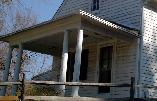 |
Belmont The Caretaker's cottage,
on Washington Street in Falmouth, built in the 1840's.
Photographed 16 Feb 2008 and Contributed by Paula Lucy Delosh |
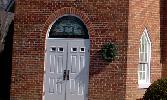 |
Berea Baptist Church Established
in 1852. During the Mud March of January 1863, Union troops used the church as a stable,
tore out the gallery and pews, and broke the windows. The church was repaired after the
Civil War. Located off Route 17.
Photographed 16 Feb 2008 and Contributed by Paula Lucy Delosh |
 |
Berea Baptist Church Entrance
door, with stained glass insert.
Photographed 16 Feb 2008 and Contributed by Paula Lucy Delosh |
 |
Clifton At Widewater.
Once time a 1,000-acre property, the first grant of land in Stafford County to William and George
Waller from the King of England. Built about 1697. During the Civil war used as a bivouac by both
Federal and Confederate troops. The housed burned in December 1945.
Contributed by Paula Lucy Delosh |
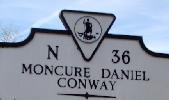 |
Moncure Daniel Conway Historic
Marker, on River Road
Photographed 2 Feb 2008 and Contributed by Paula Lucy Delosh |
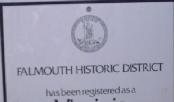 |
Falmouth Historic District Sign
mounted on the Union Church, proclaming the district as a registered Virginia Historic
Landmark
Photographed 2 Feb 2008 and Contributed by Paula Lucy Delosh |
 |
Falmouth Historic District
Highway Historic Marker
Photographed 2 Mar 2008 and Contributed by Paula Lucy Delosh |
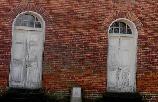 |
Falmouth Union Church Built about
1854, located on a high hill over looking the Rappahannock River.
The Federals took possession of the church during the Civil War,it was used as a hospital for
soldiers before and during the Battle of
Fredericksburg.
This church was the third church built after the previous church burned
in 1818. Because of the proliferation of religious denominations after the Revolution, it was
decided to make the new church a "union church" and so it was used by the Episcopalian,
Presbyterian, Baptist and Methodist congregations on rotating Sundays until 1950, when a violent
storm destroyed all but the facade.
Photographed 2 Feb 2008 and Contributed by Paula Lucy Delosh |
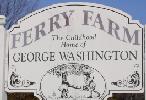 |
Ferry Farms Nothing remains of
the house in which George Washington lived between the ages of 6 and 11.
Contributed by Paula Lucy Delosh |
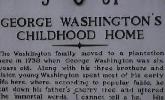 |
Ferry Farms Historical Plaque
Contributed by Paula Lucy Delosh |
 |
Golgotha Church In Falmouth,
first permanent Baptist Church, from 1892 to 1955.
Today Golgotha Church, a landmark on Cambridge Street
Photographed 26 Jan 2009 and Contributed by Paula Lucy Delosh |
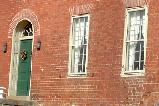 |
Gordon House On River Road, the
home was first sold in 1823 ,home of Basil B.Gordon, one of America's first millionaires.
Dealt in tobacco,cotton and general merchandise and involved in shipping. This is the second
house built on this site.
Photographed 2 Feb 2008 and Contributed by Paula Lucy Delosh |
 |
Gordon Warehouse This brick
building in Falmouth was originally used as a warehouse by Basil Gordon. Built about 1833
and at 104 River Road. Harry G.Lightner purchased the property in 1878.
Photographed 2 Feb 2008 and Contributed by Paula Lucy Delosh |
 |
Hartwood House On Route 17, 7.3
miles northeast of Falmouth, built in 1841. The property was owned by Mr. Carniers
Builder, William Irving (or Irvin), was an Irish immigrant and slave owner who sited the
home at the center of a 5,000-acre parcel between the Rappahannock River shoreline and the
Fredericksburg-Warrenton Road. The bricks were burnt in a field north of the house and
built by slaves. The house was willed to his son, Beverley C. Irvin and from him to
Beverley's daughter Sadie Irvin Lunsford (Floyd Lunsford). William died in Stafford in
1887 at the age of 81.
Photographed and Contributed by Paula Lucy Delosh |
 |
Hartwood Presbyterian Church The
present church was constructed between
1857 and 1859. A cavalry engagement took place here in February of 1863. The
interior of the church suffered considerable damage during the War. The
building was listed on the Virginia Landmarks Register and the National Register
of Historic Places in 1989.
Photographed 30 Nov 2007 and Contributed by George Seitz |
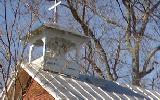 |
Hartwood Presbyterian Church
Another view.
Photographed 16 Feb 2008 and Contributed by Paula Lucy Delosh |
 |
Hartwood Presbyterian Church
Historical Marker
Photographed 16 Feb 2008 and Contributed by Paula Lucy Delosh |
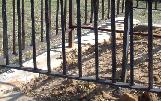 |
James Hunter Grave At Falmouth
Cemetery. A Revolutionary War manufacturer.
Photographed 2 Mar 2008 and Contributed by Paula Lucy Delosh |
 |
James Hunter Grave His headstone.
Photographed 2 Mar 2008 and Contributed by Paula Lucy Delosh |
 |
James Hunter Grave Sign erected
by Sons of the American Revolution.
Photographed 2 Mar 2008 and Contributed by Paula Lucy Delosh |
 |
Jett/Shackelford Cemetery abandoned, off White Oak Rd. only 4 headstones
remain. Many were destroyed when Federal troops were quartered nearby
Contributed by Sandra Ferguson |
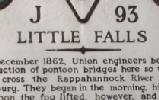 |
Little Falls Historic Marker, at
site of crossing for Federal Forces at the battle Fredericksburg
Photographed and Contributed by Paula Lucy Delosh. |
 |
Magistrate's Office At Falmouth.
Oldest municipal building in the county.
Photographed 2 Mar 2008 and Contributed by Paula Lucy Delosh |
 |
Magistrate's Office Sign
explaining significance of the building.
Photographed 2 Mar 2008 and Contributed by Paula Lucy Delosh |
 |
Overwharton Church established
ca. 1740.
Contributed by Debra Miller |
 |
Overwharton Church another view
Contributed by Debra Miller |
 |
White Oak Primitive Baptist Church on Route 218. used as a federal hospital during the Civil War. Services at
the church have continued since its establishment in 1789. On the National Register of
Historic Places.
Photographed 21 Feb 2008 and Contributed by Paula Lucy Delosh |
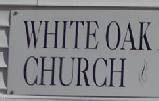 |
White Oak Primitive Baptist Church Close up of the entrance
Photographed 21 Feb 2008 and Contributed by Paula Lucy Delosh |
![]() Stafford
County Photo Album Index
Stafford
County Photo Album Index